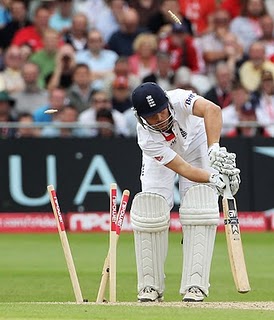
A gradual but inevitable descent into cricket-based loathing and bile.
Hot to Trott: A look at England’s Run Machine
Although it’s not uncommon for a newcomer to Test cricket to shine on debut, rarely does anyone sustain the kind of form that Jonathan Trott has shown since his debut in a pivotal Ashes match in 2009, and rarely does such a prolific run scorer seem to divide opinion. Some find him absorbing, viewing his idiosyncrasies as an intriguing window into the man with the ultimate poker-face, who turns into a run-scoring automaton every time he sets foot onto the crease. Others find his routines to be a source of annoyance and his style of play tedious, as he lacks the flair of a Pietersen or a Bell. Whichever view you take, it’s hard not to be impressed by the apparent ease in which Trott has taken to the international circuit and on the day he is crowned as the ECB player of the year, we at 51allout aim to have a closer look at the stats behind what promises to be a prolific career.
How good is this start?
At the time of writing, Trott’s record stands as:
19 tests, 31 innings, 1803 runs at an average of 66.77, with 6 centuries, 5 fifties and a high score of 226.
A record anyone (barring perhaps Don Bradman) would be proud of. So how does this compare with the start his team-mates made to their careers?
Kevin Pietersen: 19 tests, 36 innings, 1705 runs at an average of 48.71, with 5 centuries, 7 fifties and a high score of 158.
Andrew Strauss: 19 tests, 36 innings, 1716 runs at an average of 50.47, with 7 centuries, 5 fifties and a high score of 147.
Alastair Cook: 19 tests, 35 innings, 1488 runs at an average of 45.09, with 6 centuries, 5 fifties and a high score of 127.
Ian Bell MBE: 19 tests, 34 innings, 1337 runs at an average of 46.10, with 5 centuries, 8 fifties and a high score of 162*.
So what does this show us? Not only has Trott scored more runs than any of his contemporaries had at the same stage in their careers, he has done so in fewer innings. He is also the only batsman to score a double-hundred (a feat which he has managed twice so far) and his fifties/centuries conversion rate is bettered only by Andrew Strauss. This is a good indicator of how quickly Trott has adapted to the rigours placed on batsmen in the test arena and a testament to his concentration and willpower.
So how does Trott’s start compare to those of a few modern greats?
Sachin Tendulkar: 19 tests, 29 innings, 1079 runs at an average of 39.96, with 4 centuries, 4 fifties and a high score of 148*.
Ricky Ponting: 19 tests, 31 innings, 1162 runs at an average of 40.06, with 2 centuries, 7 fifties and a high score of 127.
Jacques Kallis: 19 tests, 30 innings, 842 runs at an average of 29.03, with 2 centuries, 3 fifties and a high score of 132.
Compared to these giants of the game, Trott’s record is certainly favourable, but there are a few caveats, notably that Tendulkar made his debut aged only 16, Kallis 20 and Ponting 21. Trott was 28. The only batsman of recent times who springs to mind as having made an equally spectacular start to their Test career is Mike Hussey (another late starter), whose record after 19 tests read 31 innings, 1934 runs at an average of 80.58, with 7 centuries and 8 fifties and a high score of 182. Although Hussey’s average has now dropped to just over 50, if Trott can replicate the success that Hussey has sustained over his career then surely both he and English cricket will be delighted.
How does he compare to other English number threes?
We have compared Trott’s record with all other English number threes of the past 20 years who have played at least ten innings at that position. Trott’s average of 62.60 is unsurprisingly top of the pile by some distance, Alastair Cook is second with an average of 52.54 (from only 12 innings at three) and Alec Stewart is a distant third with an average of 43.56. Trott is already fifth highest in terms of runs scored, despite occupying seventh position in innings played. Of the 13 batsmen analysed, Robert Key is the only batsman other than Trott to have scored a double hundred from the number three position and the list includes some very handy players (Michael Vaughan, Nasser Hussain & Mark Butcher). Despite criticisms of the pace of Trott’s scoring, only Key, Vaughan & Hick have better strike-rates. In summary, Trott is comfortably the best number three that England have had for a long, long time.
For more detailed analysis on the number three position have a look at our piece posted on Monday.
How the hell do you get him out?
Of Trott’s 27 test dismissals (he’s been not out four times), 13 have been caught (48%), he’s been bowled nine times (33%), trapped lbw three times (11%) and run out twice (7%). It might be easier to start with how not to get him out. The fact that he has only been out lbw a meagre three times shows his strength off his pads. As Ricky Ponting grew increasingly desperate for Trott’s wicket during the Ashes, he had his right arm seamers consistently aim at Trott’s pads over the wicket and he feasted on this, whipping everything through the leg-side. This ploy from Ponting did not work once during the series. Trott was out once to lbw, and that was from a rare inswinger that the left handed Mitchell Johnson managed to get on target during the hour at Perth where he remembered how to bowl, Trott tried to play through the offside and was pinned in front by the late movement. One of the other two times Trott has been out lbw was also to a left arm seamer, Mohammed Amir. Trott padded up to a ball angled across him and was given out, albeit somewhat dubiously. The final time he has been given out lbw was to Morne Morkel in the series in South Africa, the one time in an England shirt that he has looked uncomfortable. Whether it was the pressure of being back in SA or something else, we may never know, but it was an uncharacteristic wobble for someone usually so unflappable. This time Trott did play a loose shot across the line and was struck in front.
It’s worth asking if Ponting and Australia’s analyists had only seen Trott bat a few times and were trying to replicate this dismissal, but by and large in his career so far Trott has appeared completely untroubled by anything at his pads. Another way to generally not get him out is to bowl spin. He’s only been out four times to spinners in his career, and his dismissal by Dilshan in the recent Sri Lanka test was the first time he’d ever been out to a right-arm spinner (not that he’s played against many quality right arm spinners). Of these dismissals three have been bowled and one caught – and that was a very tame dismissal, dragging a long-hop to the square leg fielder off Shakib Al-Hasan’s left arm spin. The other time Al-Hasan got Trott was also a total fluke, described on cricinfo commentary thusly “Remarkable moment, Trott propped forward, the ball bobbled off his pad, into his elbow, and spun inexorably towards the off stump!”. He was also bowled by Paul Harris when he charged down the pitch (during his SA brain-fart) anticipating spin that never came, and was recently beaten by a faster, flatter ball by Dilshan, albeit one that came 203 runs too late.
So, really, how do you get him out?
Trott doesn’t have any obvious weaknesses, so it’s a hard question to answer, although he does have a high percentage of bowled dismissals. We’ve already looked at the spinners dismissals, so he has been bowled six times by seamers. Of these six dismissals, three have been inside edges onto the stumps from attempted off drives (off the bowling of Steyn, Johnson & Shafiul Islam) and a further two have been balls that have nipped back in and beaten that bat again when Trott has been trying to play the off drive (off Steyn & Watson). As is the case with so many batsmen it seems to be the fullish ball around or just outside off stump that can cause Trott problems (although only six of his 13 out caught dismissals have been edges to keeper or slip – not a massive ratio). However it’s a can be a dangerous game bowling that line to Trott. Stray ever so slightly onto the leg side and he will milk you for runs all day long and bowl too wide and he has the discipline to leave you alone. The best way to get Trott out may be to get inside his head. South African seemingly managed to and he looked a shadow of the run scoring robot seen before and since, but it’s much easier said than done.



No Comments
Post a Comment